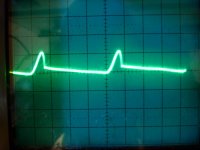patscc
Veteran Member
Pin 30 and up, which should be A0, A1, etc on that pinout diagram.
patscc
patscc

1. I need to learn how to hook up the red and black leads on my new LP-560 digital probe, I assume that will change depending on the test points.
Just so we're all on the same page, are you gonna try the terminal or the Compaq ?
patscc
I've started to read through the documenation on the FDC-1C. Things to check:
- The FDC-1C is connected as DTE via J1 on the card. That means that you should have, DB25 pins jumpered on both the terminal and the FDC-1C side as 4-5 and 6-20 on each connector. Pin 7 should be straight across to Pin 7 on the other end of the cable and Pins 2 and 3 should be swapped from end-to-end.
- Your 6116 SRAM chip should be in the U37 socket and the EPROM in the U34 socket.
- You should press <Return> slowly several times on the terminal (set to N-8-1) until you get a logon prompt
- Check to see that you have the "M1" memory map configured per the manual.
You bet'chaThis is worse than pulling teeth (no offense to my dentist ;-) )
3 weeks and 114 posts, and we still don't know whether the terminal is correctly connected and the drivers/receivers are OK. Humour me and let's go from the top:
1 - With the cable disconnected from the terminal and a paper clip or equivalent jumper between pins 2 and 3 of the terminal, does it echo what you type?
Korreckt! Not2 - When you remove that jumper does it NOT echo what you type?
Yes, (upper in my photo, closest to mobo.)3 - With the computer powered off and the cable only connected at the computer end, do you have continuity (0 ohms resistance) between pin 2 of the terminal end of the cable and pin 10 of the upper 1489?
4 - Do you also have continuity between pin 3 of the terminal end of the cable and pin 6 of the upper 1488?
5 - Still with power off, remove the upper 1488, bend pins 4 and 5 out slightly and reinsert with pins 4 and 5 out of the socket; connect a jumper between pin 8 of the 1489 and the two lifted pins 4 and 5 of the 1488.
Connect the cable at both ends and power up the terminal and the computer; does the terminal echo what you type?
Yes.and does it stop when you remove the jumper?



The Teletek has never complained, but two other boards of different manufacture did each burn up a trace at the card edge, and blew capsBy the time the little bit of ripple makes it through the voltage regulators, it won't matter one bit. So, as long as the PSU levels are okay, let's drop the power supply thing.
Every Address line and data line is showing some sort of activity, pace is different for many. The GND and +5V show up clrearly, the clock is very different, but very hard to get a handle on. As for all the data and address lines, I'm not sure the synch circuits are so very great with this scope, and it may be holding out on me. But a pulsed voltage is unmistakable even if it drifts across the scope.Let's figure out if your Z80 is even running. Scope each of the address lines coming out of the Z80 and note any that show a static level. Similarly, look at the data lines on the Z80. Let's see if the darned thing is even ticking over.
